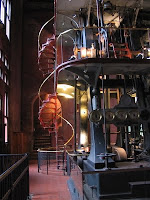In the mid-1800's as Boston's population continued to grow, the need for clean drinking water also increased. Pollution, industrial waste, and disease were all threats to general health. The pumping station and associated network of reservoirs helped to provide residents with clean drinking water - straight from the tap.
If you have visited Trinity Church or the Boston Public Library, key aspects of the museum's design will appear somewhat similar. Built during Boston's Golden Age, the museum and nearby grounds incorporated city planning, beautiful architecture, and natural materials.
I'm fairly certain that your reaction upon first glance at the pumping system will be exactly the same as mine. It is an awesome and beautiful sight to behold.
Good to Know:
- Free Admission. Admission is free to all visitors but donations are always welcome.
- Enjoyable Multimedia. Interactive kiosks provide an amazing overview of the museum's history from engineering, architecture, and clean water health.
- Convenient Location. The museum is near 3 Green Line routes (B, C, and D) and the 86 bus. There are also a number of restaurants located in the area.
- Take a Walk. The Chestnut Hill Reservoir is conveniently located right across the street. One lap is about 1.6 miles.


This is great. I have worked for every water and sewage agency in Boston and I didn't know about this.
ReplyDeleteHi Richard!
ReplyDeleteThanks for commenting. It's a great museum. You'd definitely love it. In fact, one of the engineers onsite at the time of my visit was joking about finding other engineers who would want to turn on the pumps just for old times sake (because it takes quite a team to get the system going). Who knows, they just might do it!
Take care,
Cristy